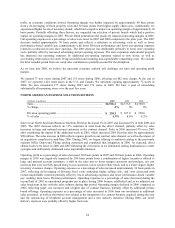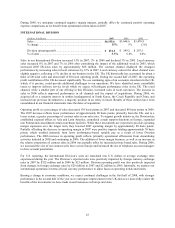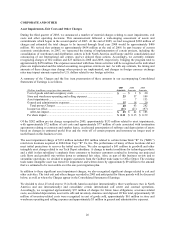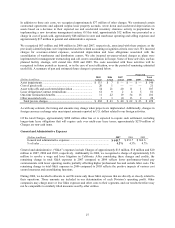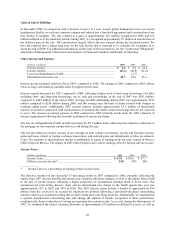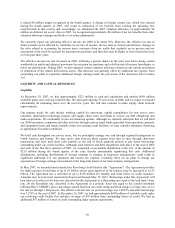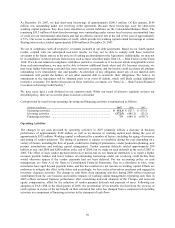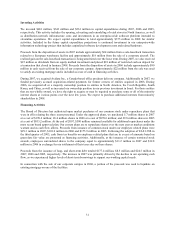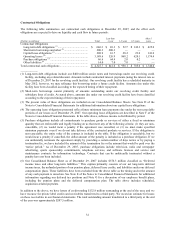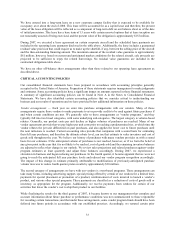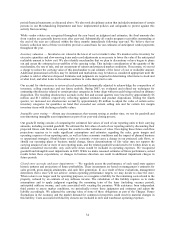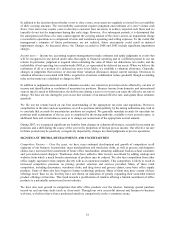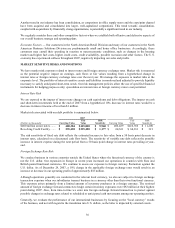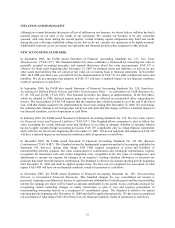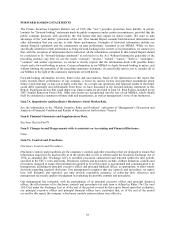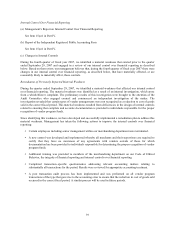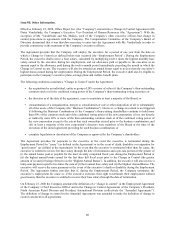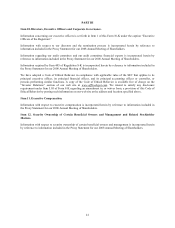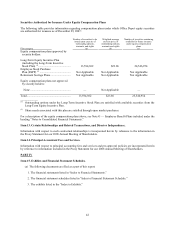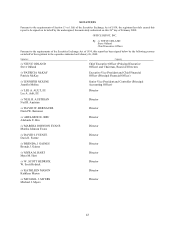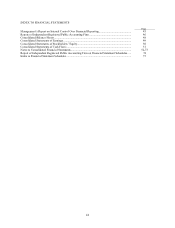Office Depot 2007 Annual Report Download - page 36
Download and view the complete annual report
Please find page 36 of the 2007 Office Depot annual report below. You can navigate through the pages in the report by either clicking on the pages listed below, or by using the keyword search tool below to find specific information within the annual report.34
period financial statements as discussed above. We also took disciplinary action that included terminations of certain
persons in our Merchandising Department and have implemented policies and safeguards to protect against this
activity from recurring.
While vendor rebates are recognized throughout the year based on judgment and estimates, the final amounts due
from vendors are generally known soon after year-end. Substantially all vendor program receivables outstanding at
the end of the year are collected within the three months immediately following year-end. We believe that our
historic collection rates of these receivables provide a sound basis for our estimates of anticipated vendor payments
throughout the year.
Inventory valuation — Inventories are valued at the lower of cost or market value. We monitor active inventory for
excessive quantities and slow-moving items and record adjustments as necessary to lower the value if the anticipated
realizable amount is below cost. We also identify merchandise that we plan to discontinue or have begun to phase
out and assess the estimated recoverability of the carrying value. This includes consideration of the quantity of the
merchandise, the rate of sale, and our assessment of current and projected market conditions. If necessary, we record
a charge to reduce the carrying value of this merchandise to our estimate of the lower of cost or realizable amount.
Additional promotional activities may be initiated and markdowns may be taken as considered appropriate until the
product is sold or otherwise disposed. Estimates and judgments are required in determining what items to stock and
at what level, and what items to discontinue and how to value them prior to sale.
Our accrual for obsolescence is reviewed each period and dynamically adjusted to acknowledge the composition of
inventory, selling experience and our future outlook. During 2007, we evaluated and refined our techniques for
estimating obsolescence related to certain product categories to better align with proceeds being realized on ultimate
disposition. The resulting obsolescence accruals in the first and second quarters were lowered by approximately $6
million and $11 million, respectively, reflecting updated estimates and product dispositions. During the fourth
quarter, we increased our obsolescence accrual by approximately $8 million to adjust the value of certain active
inventory categories for quantities on hand that exceeded our current selling rate and for certain low margin
inventory items with declining realizable values.
Intangible asset testing — Absent any circumstances that warrant testing at another time, we test for goodwill and
non-amortizing intangible asset impairment as part of our year-end closing process.
Our goodwill testing consists of comparing the estimated fair values of each of our reporting units to their carrying
amounts, including recorded goodwill. We estimate the fair values of each of our reporting units by discounting their
projected future cash flows and compare the results to other indicators of value. Developing these future cash flow
projections requires us to make significant assumptions and estimates regarding the sales, gross margin and
operating expenses of our reporting units, as well as future economic conditions and the impact of planned business
or operational strategies. Should future results or economic events cause a change in our projected cash flows, or
should our operating plans or business model change, future determinations of fair value may not support the
carrying amount of one or more of our reporting units, and the related goodwill would need to be written down to an
amount considered recoverable. Any such write down would be included in operating expenses. We recognized
goodwill and intangible asset impairments in 2005. While we make reasoned estimates of future performance, actual
results below these expectations, or changes in business direction can result in additional impairment charges in
future periods.
Closed store accruals and asset impairments — We regularly assess the performance of each retail store against
historic patterns and projections of future profitability. These assessments are based on management’s estimates for
sales growth, gross margin attainments, and cash flow generation. If, as a result of these evaluations, management
determines that a store will not achieve certain operating performance targets, we may decide to close the store.
When a store is no longer used for operating purposes, we recognize a liability for the remaining costs related to the
property, reduced by an estimate of any sublease income. The calculation of this liability requires us to make
assumptions and to apply judgment regarding the remaining term of the lease (including vacancy period),
anticipated sublease income, and costs associated with vacating the premises. With assistance from independent
third parties to assess market conditions, we periodically review these judgments and estimates and adjust the
liability accordingly. We adjusted the carrying value of some of these obligations as part of the Charges. Future
fluctuations in the economy and the market demand for commercial properties could result in material changes in
this liability. Costs associated with facility closures are included in store and warehouse operating expenses.


